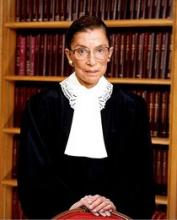Jews have long been associated with the practice of law. This only stands to reason considering Judaism's preoccupation with the details of its own religious law. Thousands of years ago, scholars of the Torah began to approach scripture from a decidedly judicial angle, using reference-supported commentaries and a foundation of precedent to elaborate on the vague elements of the written law. At its best, Jewish legal theory has been integral to the process of social justice in a variety of cultures, not the least of which is the United States where the Jewish people have cultivated a reputation as formidable lawyers. One of the greatest contributors to US law and the adjudication of civil rights is Supreme Court Justice Ruth Bader Ginsburg.
Justice Bader Ginsburg was born Ruth Joan Bader in Brooklyn, New York in 1933. She was reportedly very active as a student and also took early leadership roles in the Jewish community. She received her religious confirmation at the Midwood Jewish Center and embraced a number of everyday ritual responsibilities among her peers.
Ruth's mother passed away after a long battle with cancer just prior to Ruth's graduation from James Madison High School, now the location of a highly respected law program in Bader Ginsburg's honor. Ruth pursued her undergraduate degree at Cornell University then attended the Harvard School of Law. She married Martin D. Ginsburg in 1954, relocating with him back to New York City where she continued her law studies at Columbia University. Martin Ginsburg is currently a nationally renowned professor at Georgetown University. The Gingburgs have two children together, Jane and James.
Ruth Bader Ginsburg became a professor of law at Rutgers University less than a decade after passing the Bar. While there she began her extensive work in gender equality law, founding the Women's Rights Law Reporter journal, eventually attaining a tenured position at Columbia. She continued her work in women's rights when she took up the mantle of chief litigator for the American Civil Liberties Union concerning their cases in gender equality.
After serving as the judge for the appellant court of Washington D.C. for several years, Ruth Bader Ginsburg was appointed to the Supreme Court of the United States by President Bill Clinton. In her time there Justice Bader Ginsburg has maintained her reputation as a liberal-leaning judge, coming down in favor of reproductive rights, workplace equality and overall anti-discrimination concerns. Recently, Ruth Bader Ginsburg has had her own ongoing struggle with cancer. She has been at the bench since February 2009 after undergoing surgery to remove a tumor from her pancreas and has been in relatively good health. The 76-year-old Justice has made no comments concerning retirement.
Over the course of her extensive career, Ruth Bader Ginsburg has become a symbol of progressive politics and social reform. As the first Jewish Supreme Court Justice, she has represented her people honorably and admirably. For all young Jews of any gender, Ruth Bader Ginsburg is a fine example of how to pursue tikun olam in the world of law.
